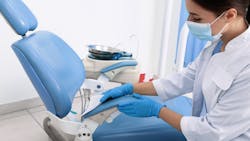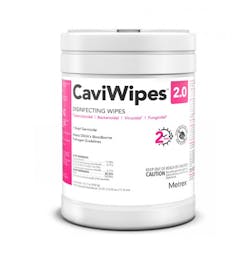Chairside Impact: CaviWipes 2.0 by Kerr Dental
We sometimes forget hygienists are superheroes. It may sound silly, but we do serve and protect our patients in countless ways. In recent months, infection control measures have come under more scrutiny than ever before. Just as the HIV epidemic spurred glove-wearing to reduce direct contact with blood-borne pathogens, dentistry has become more proactive in preventing cross-contamination with aerosols and spatter. We have undoubtedly advanced our field immeasurably in the short span of time since the onset of the pandemic.
Of course, these adjustments haven’t come without frustration. Although face shields are a long-overdue, spatter-reducing measure, many of them create blinding glare from our loupe lights, and many don’t fit our loupes well to begin with. Airborne pathogens in our operatories take forever to settle, and many offices have not found a workable solution for this. Even prerinse options are often ineffective against viruses, and there isn’t much guidance on effective and accessible alternatives. Changes in mask regulations, though necessary, have created much discomfort for most health-care workers. I’ve found that I breathe through my mouth and protrude my mandible all day in order to keep the ill-fitting KN95 from venturing into my eyes (and I’m treated to daily TMJ pain by 3 pm as a result). Ultimately, some changes take time and trial-and-error to perfect, but we know that the result will be more advanced protocols and better standards of care.
More Chairside Impact:
One easy adjustment, however, has to do with infection control products. Many practices have reexamined their disinfectant selections forAdditionally, these new wipes tested very well on all included materials on both in-house and third-party safety tests. Original CaviWipes are recommended in 75 manufacturers’ use instructions, and the new 2.0 wipes have near-identical results (even better on some materials). This eliminates the need to use multiple disinfectant agents between patients. For my practice, this means we don’t have to worry that all the wiping will cause wear to our units over time.
CaviWipes 2.0 feature a new two-minute kill time. This means clinicians can bring instruments to sterilization after wiping and trust that when we return, our rooms will be fully disinfected and ready for the next procedure. This has been a huge plus for our practice. Lastly, this formula is effective on nonvisibly soiled surfaces with just one wipe down. (Heavily soiled areas still need a second pass in accordance with Centers for Disease Control and Prevention guidelines.2) This saves clinicians another three minutes each time there’s no debris on a surface by eliminating the second pass and wait time.
Overall, I noticed the same quality I have come to know from the CaviCide family of products—no residue, harsh fumes, discolorations of operatory materials, etc. I’ll continue using these knowing I’m disinfecting quickly and properly; just one more way I’m protecting and serving my patients, coworkers, and myself.
Editor's note: This article appeared in the December 2021 print edition of RDH magazine.
References
- Guidance to registrants: process for making claims against emerging viral pathogens not on EPA-registered disinfectant labels. August 19, 2016. https://www.epa.gov/sites/default/files/2016-09/documents/emerging_viral_pathogen_program_guidance_final_8_19_16_001_0.pdf
- Cleaning and disinfecting environmental surfaces. Centers for Disease Control and Prevention. March 25, 2016. https://www.cdc.gov/oralhealth/infectioncontrol/faqs/cleaning-disinfecting-environmental-surfaces.html
About the Author

Michelle MacLean, RDH
Michelle MacLean, RDH, is a full-time clinical hygienist in a general practice near Atlanta, Georgia. She is an enthusiastic spokesperson for hygiene workforce improvements and consistent standards for patient care. She creates hygiene management resources and has implemented protocols compliant with the 2017 World Workshop on Periodontal Diseases and Conditions. She can be reached at [email protected].
Updated September 27, 2022

